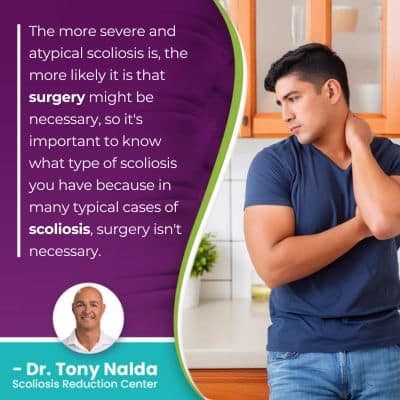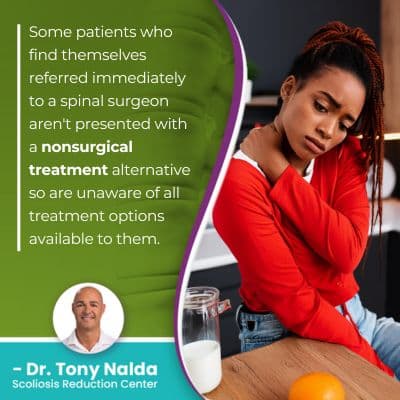Scoliosis Surgery: Essential Questions to Ask Your Surgeon

Many cases of scoliosis don't require surgical intervention, and the success rate of nonsurgical treatment speaks for itself. Choosing to commit to one treatment approach over another will shape the spine's long-term spinal health and function so is an important decision.
When it comes to scoliosis surgery, we're talking about spinal fusion. Spinal fusion is a lengthy, invasive, and costly procedure that isn't always necessary. Knowing the right questions to ask your doctor can mean making an informed treatment choice.
Before getting to the specific questions to ask your doctor and/or surgeon, let's discuss the two main treatment approaches in general.
Scoliosis Treatment Options
Scoliosis causes a loss of the spine's healthy curves, and the spine's natural curves make it stronger, more flexible, and better able to absorb and distribute mechanical stress.
There are a number of spinal conditions that involve the development of an unnatural spinal curve, but scoliosis has some characteristics that set it apart from the rest.
Not only is scoliosis progressive, meaning its nature is to get worse over time, it causes the spine to bend unnaturally to the side and also twist, making it a 3-dimensional condition.
In order for the unnatural bend and twist in the spine to be diagnosed as a true scoliosis, the size of the curve has to be a minimum of 10 degrees, and this is determined by a measurement known as Cobb angle.
Once a condition is diagnosed, the most important choice to be made is how to treat it moving forward; as a progressive condition, there is no curing scoliosis, and treatment is more about managing an ongoing condition for the best quality of life.
Traditional vs Conservative Treatment Options
The two main scoliosis treatment options are traditional surgical treatment and modern conservative nonsurgical treatment.
Traditional treatment doesn't respond to a diagnosis of mild scoliosis proactively, instead commonly recommending merely watching and waiting for continued progression; to me, this is wasting valuable treatment time because virtually every case of scoliosis will get worse at some point.
Modern conservative treatment responds proactively by starting treatment as close to the time of diagnosis as possible; this is when conditions are at their mildest and most likely to respond well to treatment.
So when you are recently diagnosed, these are some questions you should ask your doctor to determine whether surgery is really necessary for you or not:
- "How Severe is My Condition?"
Condition severity is a key piece of condition information that treatment plans are shaped around, so make sure you know how severe your condition is, along with the different severity levels.
 A patient's scoliosis is classified as mild scoliosis, moderate scoliosis, severe or very severe scoliosis, and this is determined by a measurement known as Cobb angle.
A patient's scoliosis is classified as mild scoliosis, moderate scoliosis, severe or very severe scoliosis, and this is determined by a measurement known as Cobb angle.
A patient's Cobb angle is determined during X-ray by drawing lines from the tops and bottoms of the curve's most-tilted vertebrae, and the more unnaturally tilted, the further out of alignment the spine is, and the more severe the condition is, and noticeable its effects are likely to be.
The milder a condition is at the time of diagnosis, the simpler it is to treat, so while a traditional treatment approach would recommend only watching and waiting, because they don't have a strategy for treating scoliosis while mild, conservative treatment would be started immediately following the diagnosis.
So understanding condition severity is important because it's a factor that affects how the spine will respond to treatment.
- "What Type of Scoliosis Do I Have?"
Not only are there different severity levels of scoliosis, there are also different types, and this is determined by causation.
In the majority of scoliosis cases, we don't know what triggers the initial onset, and this is idiopathic scoliosis, accounting for approximately 80 percent of known diagnosed cases, and the remaining 20 percent of known cases consist of neuromuscular scoliosis, congenital scoliosis, and degenerative scoliosis.
In typical cases of idiopathic scoliosis, curves bend to the right, away from the heart, but in atypical cases, such as neuromuscular scoliosis, curves can bend to the left, towards the heart, and this complicates the treatment process and tells me there is an underlying pathology causing the development of the scoliosis.
The more severe and atypical scoliosis is, the more likely it is that surgery might be necessary, so it's important to know what type of scoliosis you have because in many typical cases of scoliosis, surgery isn't necessary.
- "What Type of Scoliosis Treatment Do You Specialize In?"
Depending on the path of your diagnosis, different treatment providers funnel patients in different treatment directions, so it's important to know which type of treatment your doctor is likely to recommend: surgical or nonsurgical treatment.
If you're talking to a scoliosis chiropractor, conservative nonsurgical treatment is going to be recommended, and if talking to a spinal surgeon, it's likely that spinal fusion will be recommended when/if a patient progresses into the severe classification.
Some patients who find themselves referred immediately to a spinal surgeon aren't presented with a nonsurgical treatment alternative so are unaware of all treatment options available to them.
For those patients who have opted for spinal surgery because their conditions are particularly severe or atypical, there are some questions they should ask their surgeon to be prepared.
- "What Does the Process of Spinal Fusion Involve?"
It's important to understand the process of spinal fusion to fully understand how it shapes spinal health in the future.
The process of spinal fusion involves fusing the curve's most-tilted vertebrae into one solid bone, and this is done to eliminate movement in that portion and commonly involves the removal of intervertebral discs that sit between adjacent vertebral bodies to be fused.
The process then involves attaching rods to the spine with pedicle screws to hold it in place. While there are different types of spinal fusion, some that involve the use of adjustable tethers instead of rods, the concept is the same and holds the spine in a straighter alignment.
- "What Are the Risks Associated with the Procedure of Spinal Fusion Itself?"
 All surgeries come with their share of risks, and spinal surgery is no exception; due to the fact that the brain and spine work together to form the body's central nervous system, spinal surgery can be particularly invasive and risky.
All surgeries come with their share of risks, and spinal surgery is no exception; due to the fact that the brain and spine work together to form the body's central nervous system, spinal surgery can be particularly invasive and risky.
The extensive procedure carries the risk of nerve damage, excessive blood clots and/or loss, infection, and adverse reaction to hardware used.
While spinal surgeons have their patients' best interests at heart, these are serious risks so should be considered carefully.
- "What Are the Long Term Consequences of Spinal Fusion Surgery?'
This is one of the most important questions to ask because how a diagnosis of scoliosis is responded to will shape the spine's long-term health and function, something that affects a person's quality of life.
Many patients are disappointed with the loss of spinal flexibility and range of motion they are left with, and this is because the goal of spinal fusion is to stop conditions from progressing, but this means eliminating movement in the fused portion of the spine.
Spinal rigidity can be painful and lead to activity restrictions, and in addition, a fused spine is weaker and more vulnerable to injury, and this can have an emotional effect that shouldn't be discounted.
A fused spine is fused for life, and if for any reason, the fusion is unsuccessful, the only recourse is more surgery, and the risks of spinal fusion increase with age and each subsequent procedure.
Conclusion
What I want most for all scoliosis patients is to be informed so they can make the best possible treatment choice, and that means being aware of all potential risks of spine surgery.
When treated conservatively, this involves condition-specific chiropractic care, physical therapy, corrective bracing, and a rehabilitation program to further heal and stabilize the spine for sustainable long-term treatment results.
Orthopedic spine surgeons have their patients' best interests at heart, but surgically addressed scoliosis permanently alters the health and function of the spine, and when it comes to whether or not to commit to scoliosis surgery, it never hurts to get a second opinion, find out the surgeon's personal success rate, and ensure they have the appropriate qualifications.
Scoliosis requires immediate medical attention because as a progressive condition, sometimes when treatment is started is as important as the type of treatment started; the best time to start scoliosis treatment is always now.
While some patients maintain enough spinal flexibility above and below the fused portion of the spine, other patients experience a noticeable loss that impacts quality of life.
When it comes to surgery recovery time, this involves wound healing, surgical incision care, pain management, and a hospital stay.
Here at the Scoliosis Reduction Center, a patient's physical and mental well-being are my concern, and my patients benefit from a nonsurgical treatment alternative that's proactively started as close to the time of diagnosis as possible.
Dr. Tony Nalda
DOCTOR OF CHIROPRACTIC
After receiving an undergraduate degree in psychology and his Doctorate of Chiropractic from Life University, Dr. Nalda settled in Celebration, Florida and proceeded to build one of Central Florida’s most successful chiropractic clinics.
His experience with patients suffering from scoliosis, and the confusion and frustration they faced, led him to seek a specialty in scoliosis care. In 2006 he completed his Intensive Care Certification from CLEAR Institute, a leading scoliosis educational and certification center.
About Dr. Tony Nalda
 Ready to explore scoliosis treatment? Contact Us Now
Ready to explore scoliosis treatment? Contact Us Now





